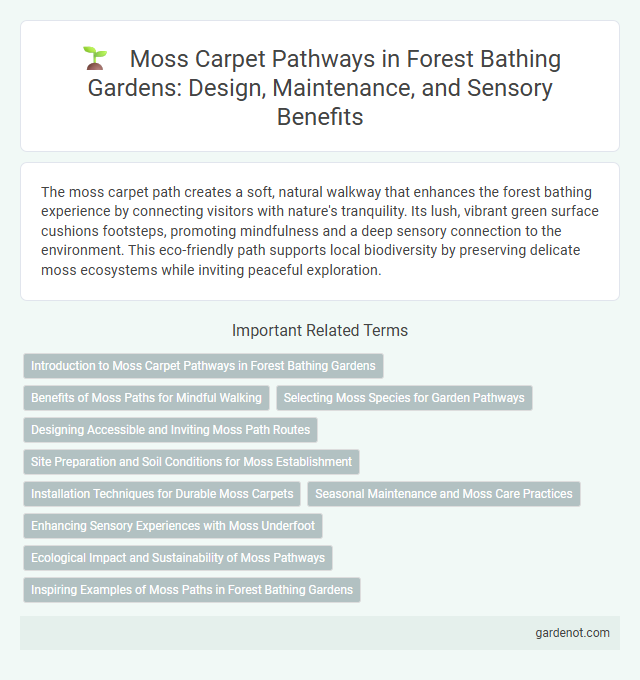The moss carpet path creates a soft, natural walkway that enhances the forest bathing experience by connecting visitors with nature's tranquility. Its lush, vibrant green surface cushions footsteps, promoting mindfulness and a deep sensory connection to the environment. This eco-friendly path supports local biodiversity by preserving delicate moss ecosystems while inviting peaceful exploration.
Introduction to Moss Carpet Pathways in Forest Bathing Gardens
Moss carpet pathways serve as a serene element in forest bathing gardens, enhancing sensory immersion through their soft texture and vibrant green hues. These pathways support natural moisture retention and promote biodiversity by providing habitat for small insects and fungi. Integrating moss carpets into forest trails encourages mindful walking and deepens the connection with nature's subtle rhythms.
Benefits of Moss Paths for Mindful Walking
Moss carpet paths enhance mindful walking by providing a soft, natural surface that reduces noise and encourages slow, deliberate steps, fostering deeper sensory engagement with the environment. The lush green texture of moss absorbs stress and promotes tranquility, helping walkers achieve a meditative state and improved mental clarity. This calming effect supports reduced anxiety, heightened presence, and a stronger connection to nature during forest bathing experiences.
Selecting Moss Species for Garden Pathways
Selecting moss species for garden pathways involves choosing varieties with dense, low-growing textures that thrive in shaded, moist environments such as Hypnum, Leucobryum, and Dicranum. These species create a soft, natural carpet that enhances walkability while promoting biodiversity and soil health. Proper site preparation and maintenance, including shade provision and moisture control, ensure the moss carpet path remains lush and resilient throughout the seasons.
Designing Accessible and Inviting Moss Path Routes
Designing accessible and inviting moss carpet paths requires careful consideration of terrain stability and surface texture to ensure safe navigation for all visitors. Incorporating gentle slopes and wide, even walkways enhances accessibility while preserving the delicate moss ecosystem. Utilizing natural materials like wooden boardwalks or stone stepping stones can seamlessly blend with the environment, providing both comfort and an immersive forest bathing experience.
Site Preparation and Soil Conditions for Moss Establishment
Site preparation for a moss carpet path requires thorough clearing of debris and ensuring a shaded environment to mimic natural moss habitats. Soil conditions must be acidic with a pH between 5.0 and 6.5, consistently moist but well-drained, to promote moss growth and prevent drying out. Compacted soil should be gently loosened to enhance water retention and root adherence, creating an optimal substrate for moss establishment.
Installation Techniques for Durable Moss Carpets
Creating durable moss carpets on forest bathing paths involves careful site assessment to ensure suitable moisture, shade, and soil acidity conditions. Installation techniques include preparing the substrate by removing debris and compacting the soil, followed by selecting resilient moss species that thrive locally, and securing them with biodegradable mesh or netting to promote establishment. Regular maintenance such as gentle watering and minimal foot traffic helps sustain moss vitality and prevents damage, ensuring long-lasting green coverage.
Seasonal Maintenance and Moss Care Practices
Seasonal maintenance of a moss carpet path involves regular cleaning to remove debris and prevent fungal growth, especially during wet and humid months. Moss care practices include gentle watering with a fine mist to maintain moisture without waterlogging, along with occasional shading to protect the moss from direct sunlight and temperature extremes. Ensuring proper soil acidity and aeration promotes healthy moss growth and longevity throughout changing seasons.
Enhancing Sensory Experiences with Moss Underfoot
Walking along a moss carpet path intensifies sensory experiences by providing a soft, cushiony surface that gently absorbs footsteps, heightening awareness of every step. The vibrant green moss enhances visual appeal while its natural moisture and texture stimulate tactile senses, deepening connection with nature. This immersive ground cover promotes mindful walking, encouraging relaxation and grounding in the forest environment.
Ecological Impact and Sustainability of Moss Pathways
Moss carpet paths significantly reduce soil erosion and improve water retention, promoting a healthier forest ecosystem. These pathways are sustainable due to their low-impact installation methods that preserve native vegetation and minimize disturbance. By maintaining natural ground cover, moss paths support biodiversity and enhance carbon sequestration in forest environments.
Inspiring Examples of Moss Paths in Forest Bathing Gardens
Moss carpet paths create a lush, soft underfoot experience that enhances the sensory immersion in forest bathing gardens. Notable examples include the Tai Lue Moss Path in Thailand's Doi Inthanon National Park, where dense moss blankets winding trails, encouraging mindful walking and connection with nature. The Portland Japanese Garden in Oregon features carefully cultivated moss carpets that invite visitors to slow down and engage deeply with the forest ecosystem.
Moss carpet path Infographic

 gardenot.com
gardenot.com